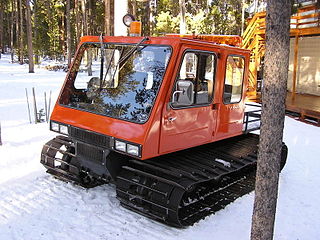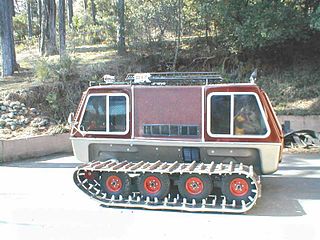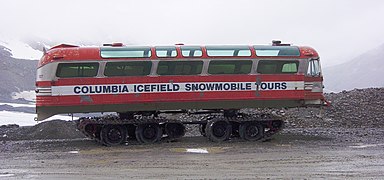Transport in Antarctica has transformed from explorers crossing the isolated remote area of Antarctica by foot to a more open era due to human technologies enabling more convenient and faster transport, predominantly by air and water, but also by land as well. Transportation technologies on a remote area like Antarctica need to be able to deal with extremely low temperatures and continuous winds to ensure the travelers' safety. Due to the fragility of the Antarctic environment, only a limited amount of transport movements can take place and sustainable transportation technologies have to be used to reduce the ecological footprint. The infrastructure of land, water and air transport needs to be safe and sustainable. Currently thousands of tourists and hundreds of scientists a year depend on the Antarctic transportation system.

Bombardier Inc. is a Canadian business jet manufacturer. It was also formerly a manufacturer of commercial jets, public transport vehicles, trains, and recreational vehicles, with the last being spun-off as Bombardier Recreational Products. The company originally produced snowmobiles, over the years it expanded into the aviation, rail, and public transit businesses.

A snowmobile, also known as a Ski-Doo, snowmachine, sled, motor sled, motor sledge, skimobile, or snow scooter, is a motorized vehicle designed for winter travel and recreation on snow. It is designed to be operated on snow and ice and does not require a road or trail, but most are driven on open terrain or trails. Snowmobiling is a sport that many people have taken on as a serious hobby.

Joseph-Armand Bombardier was a Canadian inventor and businessman who was the founder of Bombardier. His most famous invention was the snowmobile.

Bombardier Recreational Products Inc., operating as BRP, is a Canadian manufacturer of snowmobiles, all-terrain vehicles, motorcycles, and personal watercraft. It was founded in 2003, when the Recreational Products Division of Bombardier Inc. was spun-off and sold to a group of investors consisting of Bain Capital, the Bombardier-Beaudoin family and the Caisse de dépôt et placement du Québec. Bombardier Inc., was founded in 1942 as L'Auto-Neige Bombardier Limitée by Joseph-Armand Bombardier at Valcourt in the Eastern Townships, Quebec.

An off-road vehicle sometimes refer to as an overland or adventure vehicle is considered to be any type of vehicle which is capable of driving on and off paved or gravel surface. It is generally characterized by having large tires with deep, open treads, a flexible suspension, or even caterpillar tracks. Other vehicles that do not travel public streets or highways are generally termed off-highway vehicles, including tractors, forklifts, cranes, backhoes, bulldozers, and golf carts.

The Columbia Icefield is the largest ice field in North America's Rocky Mountains. Located within the Canadian Rocky Mountains astride the Continental Divide along the border of British Columbia and Alberta, Canada, the ice field lies partly in the northwestern tip of Banff National Park and partly in the southern end of Jasper National Park. It is about 325 square kilometres (125 sq mi) in area, 100 metres (330 ft) to 365 metres (1,198 ft) in depth and receives up to 7 metres (280 in) of snowfall per year.

The Tucker Sno-Cat is a family of tracked vehicles for snow conditions, manufactured in Medford, Oregon by the company of the same name.
Thiokol was an American corporation concerned initially with rubber and related chemicals, and later with rocket and missile propulsion systems. Its name is a portmanteau of the Greek words for sulfur and glue, an allusion to the company's initial product, Thiokol polymer.

A snowcat is an enclosed-cab, truck-sized, fully tracked vehicle designed to move on snow. Major manufacturers are Pisten Bully (Germany), Prinoth (Italy) and Tucker.

Snow grooming is the process of manipulating snow for recreational uses with a tractor, snowmobile, piste caterpillar, truck or snowcat towing specialized equipment. The process is used to maintain ski hills, cross-country ski trails and snowmobile trails by grooming the snow on them. A snow groomer is usually employed to pack snow and improve skiing and snowboarding and snowmobile trail conditions. The resulting pattern on the snow is known as corduroy, and is widely regarded as a good surface on which to ski or ride. Snow groomers can also move accumulated snow made by snow machines as part of a process, called "snow farming".

Aerosani [singular = plural] is a type of propeller-driven snowmobile, running on skis, used for communications, mail deliveries, medical aid, emergency recovery and border patrolling in northern Russia, as well as for recreation. Aerosani were used by the Soviet Red Army during the Winter War and World War II.

The Athabasca Glacier is one of the six principal 'toes' of the Columbia Icefield, located in the Canadian Rockies. The glacier currently loses depth at a rate of about 5 metres (16 ft) per year and has receded more than 1.5 km (0.93 mi) and lost over half of its volume in the past 125 years. Easily accessible, it is the most visited glacier in North America. The leading edge of the glacier is within easy walking distance; however, travel onto the glacier is not recommended unless properly equipped. Hidden crevasses have led to the deaths of unprepared tourists.

A winter service vehicle (WSV), or snow removal vehicle, is a vehicle specially designed or adapted to clear thoroughfares of ice and snow. Winter service vehicles are usually based on a dump truck chassis, with adaptations allowing them to carry specially designed snow removal equipment. Many authorities also use smaller vehicles on sidewalks, footpaths, and cycleways. Road maintenance agencies and contractors in temperate or polar areas often own several winter service vehicles, using them to keep the roads clear of snow and ice and safe for driving during winter. Airports use winter service vehicles to keep both aircraft surfaces, and runways and taxiways free of snow and ice, which, besides endangering aircraft takeoff and landing, can interfere with the aerodynamics of the craft.

Aktiv Grizzly is dual-track snowmobile manufactured by Aktiv Maskin Östersund AB in Sweden. The snowmobile is equipped with dual 38 x 384 cm tracks and single front ski. Also dual front skis has been available for XP. Tracks cover area almost 1 m2, making it well suited for deep-snow operations. The Grizzly is powered by a 497 ccm Rotax 503 Scandinavia, producing 38 HP (28 kW) at 5700 RPM. The carb is a VM 32, supplied by Mikuni. Earlier Grizzly have 1+N+1 gearbox and last model (XP) (1989–1991) have 1+N+2 gearbox. The Grizzly was produced from 1979 to 1991. It is still recognized one of the best dual track snowmobile in the world. Both Bombardiers Ski-Doo Alpine, Ski-Doo Alpine 2 and Ockelbo 8000 are similar dual-track snowmobiles. In the mid 80's, the Grizzly switched from the traditional wheelbased bogie to a flexible joint-bogie, which made the ride smoother and the passability much better.

The Snow Trac is a small personal Snowcat that is roughly the size of a modern compact car.

Kristi snowcats were 1950s/1960s tracked vehicles suitable for snow and other terrain and produced originally in Colorado and then later in Washington.

Logan Manufacturing Company was a US manufacturer of snowcats that ceased operation in 2000. LMC is both the tradename and an acronym.

Road signs in Iceland conform to the general pattern of those used in most other European countries, with certain design elements borrowed from Danish and Swedish practice. Signs tend to be more sparsely employed than in other European countries, especially in rural areas.

Neumayer-Station III, also known as Neumayer III after geophysicist Georg von Neumayer, is a German Antarctic research station of the Alfred-Wegener-Institut. It is located on the approximately 200 metres (660 ft) thick Ekström Ice Shelf several kilometres south of Neumayer-Station II. The station's assembly kit was transported to its current position early in November 2007. It is moving with the shelf ice at about 200 meters (660 ft) per year towards the open sea.
























